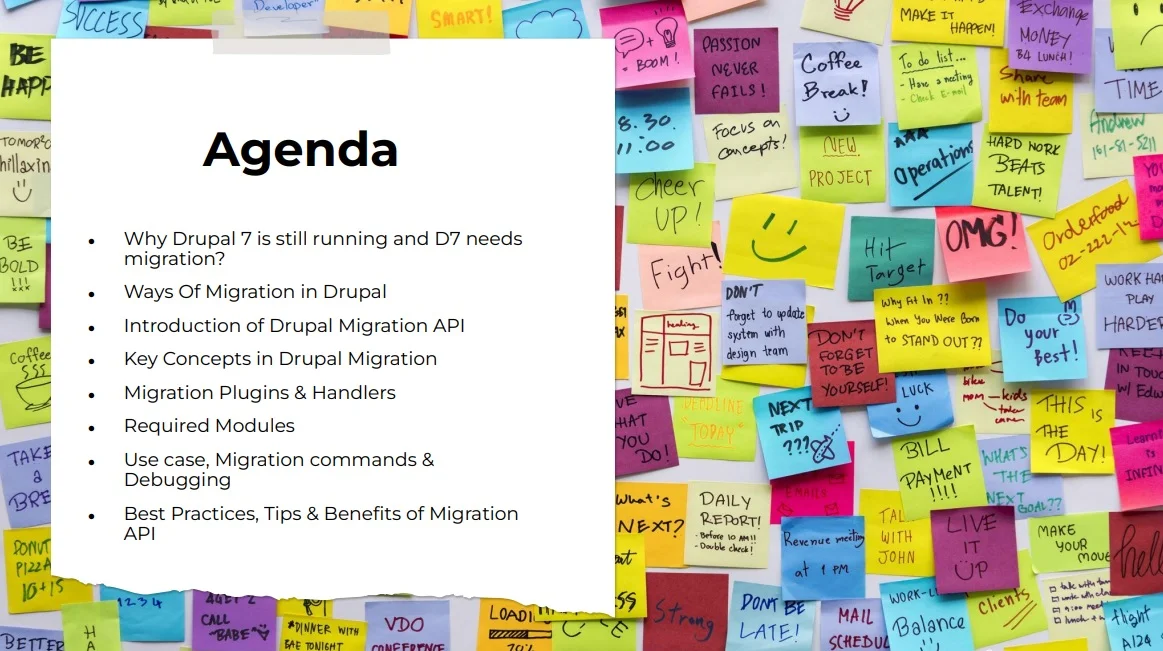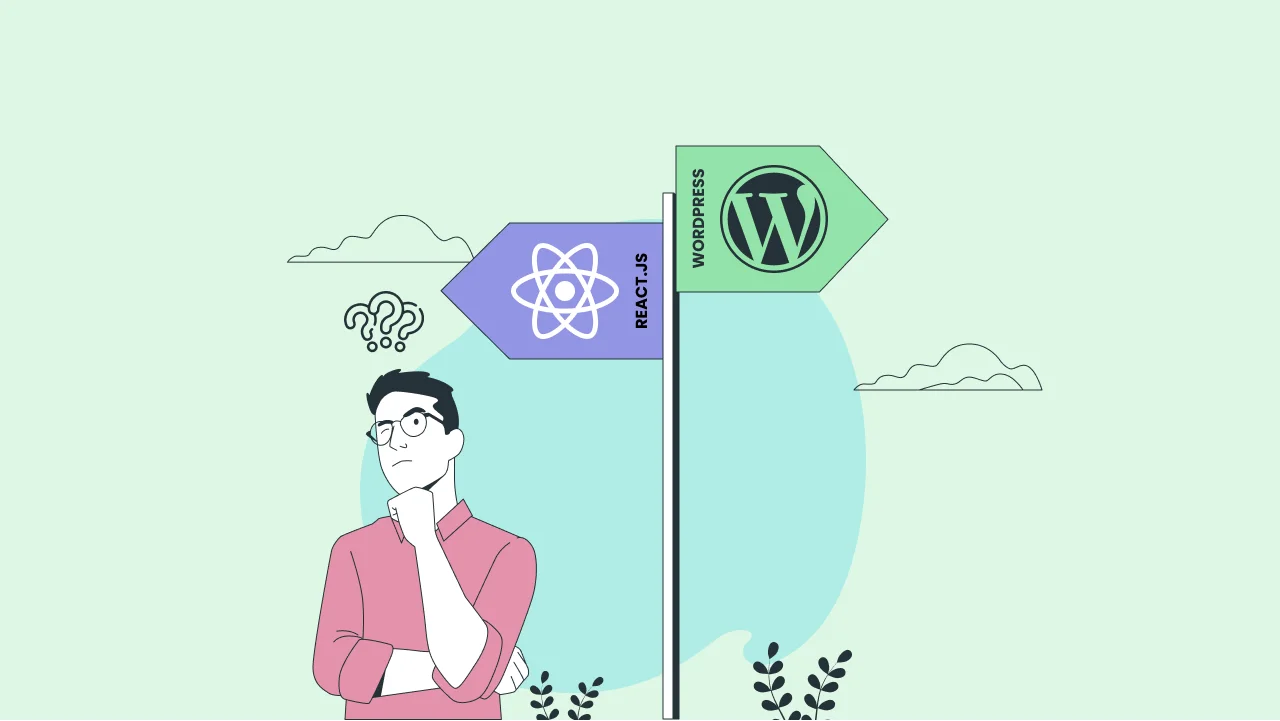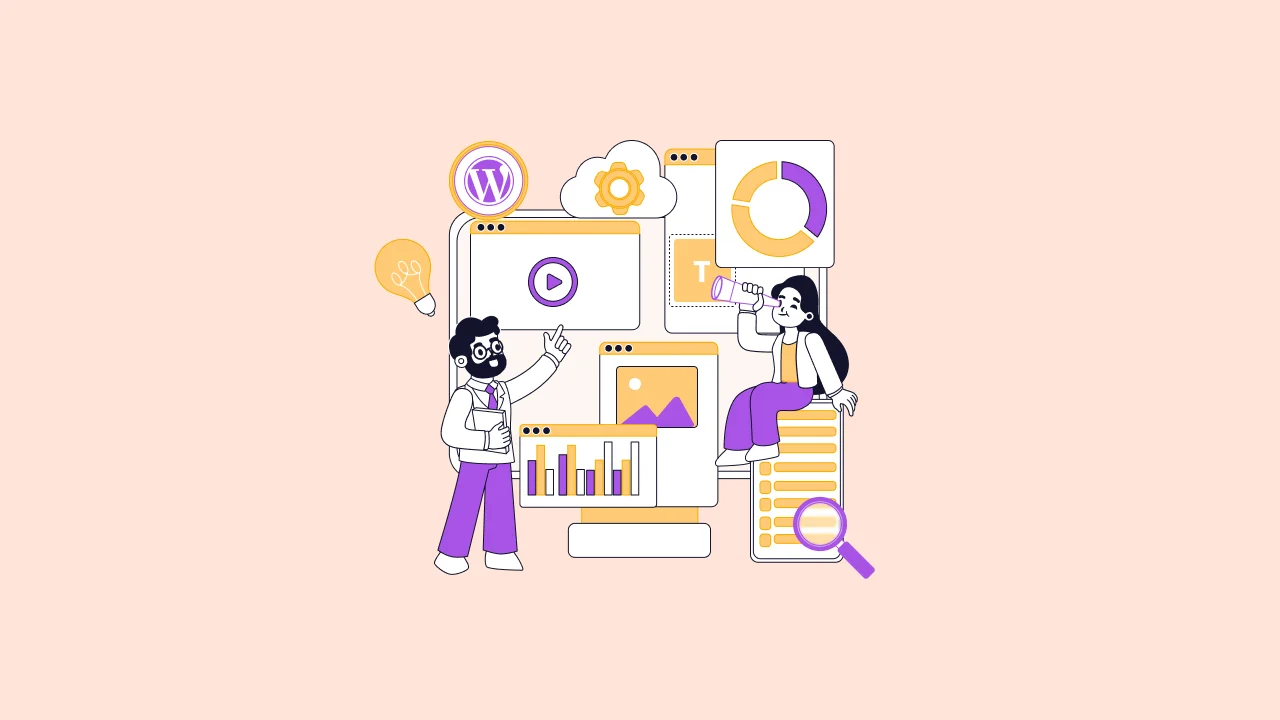Greetings, fellow developers and Drupal enthusiasts! I’m thrilled to share my recent experience as a speaker at the Drupal meetup in Ahmedabad, where I delved into the intriguing realm of Drupal 7 Migration API by Spreadsheet / CSV. If you’re curious about this topic, I’m here to offer you a comprehensive guide on how to navigate the complexities of migrating from Drupal 7 to newer versions using spreadsheet or CSV data.
1) Why Drupal 7 Still Holds Ground?
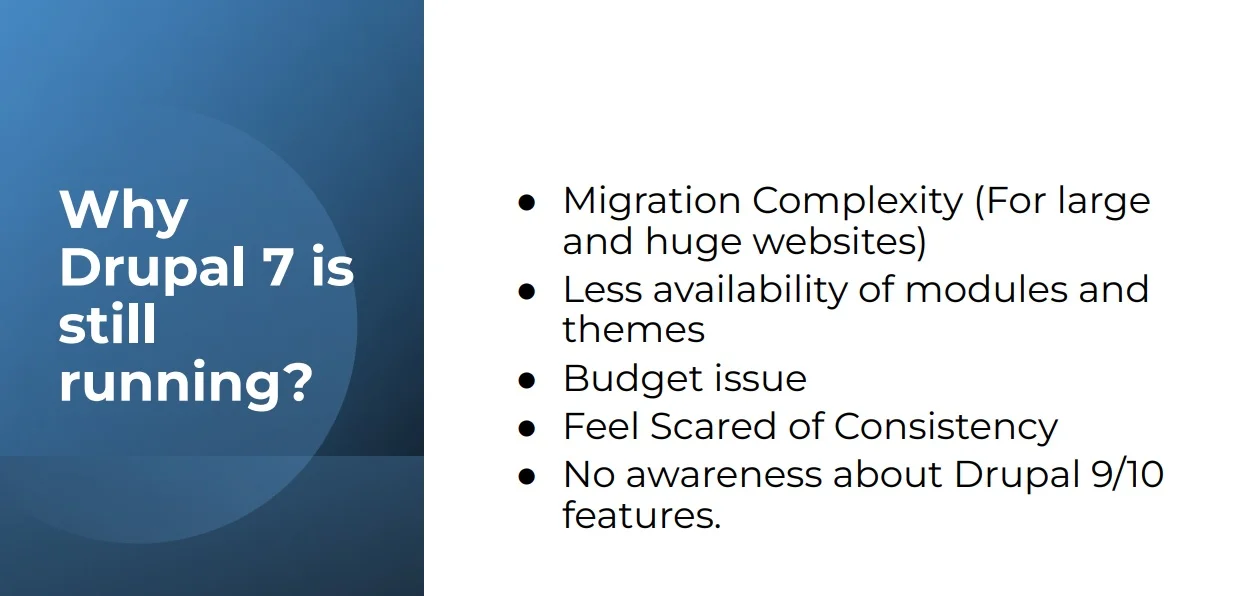
Before we dive into the technical aspects of migration, let’s address why Drupal 7 continues to thrive in some scenarios:
- Migration Complexity:
Upgrading from Drupal 7 to Drupal 8 (or later versions) involves a significant amount of work, as it’s not a simple one-click process. Many websites might have custom themes, modules, and configurations that need to be adapted or rewritten for the new version. This can be a time-consuming and expensive process, particularly for larger and more complex websites.
- Module and Theme Availability:
When Drupal releases a new version, it often takes time for developers to update their modules and themes to be compatible with the new version. Some websites rely on specific modules that might not be available or fully functional in newer Drupal versions, which can hinder the migration process.
- Budget Constraints:
Organizations might not have the budget or resources to invest in a complete website overhaul and migration. Migrating to a new version of Drupal can involve costs related to development, testing, training, and potential downtime during the migration process.
- Fear of Inconsistency:
Drupal 7 stable version has released in 2011. Drupal 7 had been around for several years by 2023 and had undergone multiple updates and improvements. Drupal 7 takes time to be the most stable version and maintain that stability. Many organizations prefer to stick with a version that is stable and well-tested, especially if their website is functioning well and meeting their needs.
- Lack of Awareness:
Organizations might be uncertain about the benefits of migrating to a newer version. They might question whether the features and improvements in the newer version justify the cost and effort of migration.
2) The Imperative Need for Drupal 7 Migration
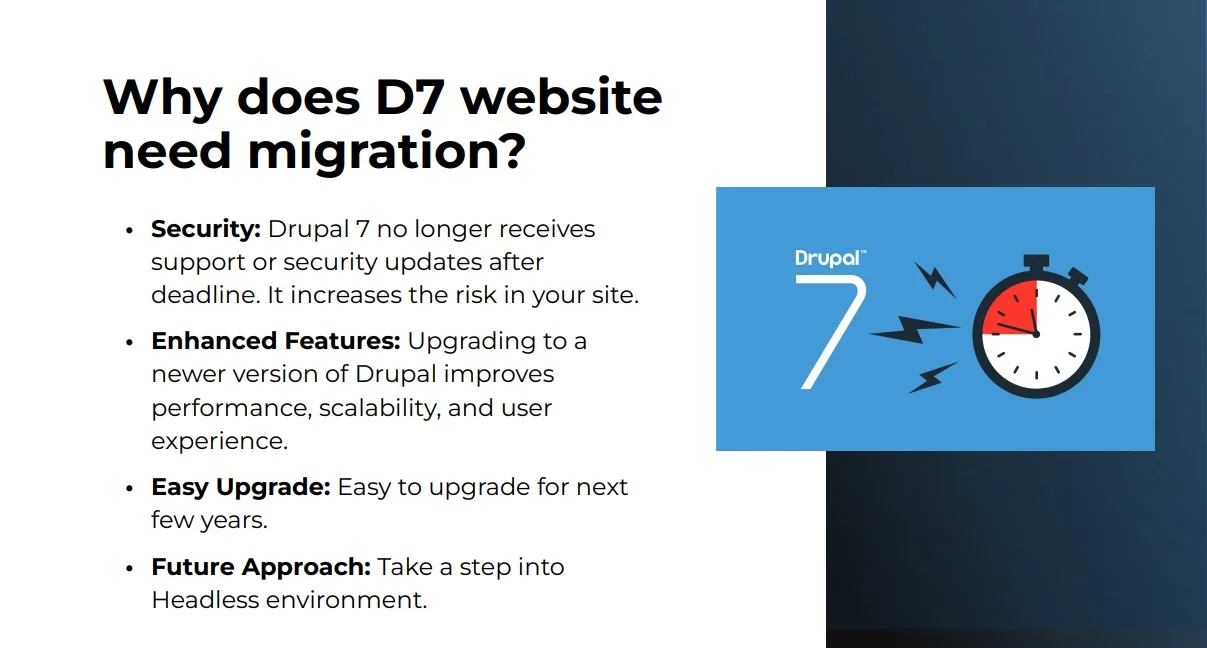
Now, let’s explore the reasons that make migrating from Drupal 7 imperative:
- Security Concerns:
With the Drupal community and safety crew prioritizing and actively that specialize in safety of Drupal 9/10, you could relaxation assured that your website is safe. The elimination of deprecated code method you have got a leaner codebase, accordingly reducing possibilities of security risks or errors.
- Enhanced Features:
Upgrading to a newer version, such as Drupal 9 or 10, leads to improved performance, scalability, and enhanced user experiences.
- Easy Upgrades:
With the massive jump from Drupal 7, it’s obvious to think that once you have migrated to Drupal 9/10, upgrading to the cutting-edge Drupal release may be a trouble whenever going ahead. that is simply no longer the case. Easy to upgrade for next few years.
- Future-proofing:
Embracing migration is a stepping stone towards adopting a Headless CMS environment for future development.
3) Navigating Drupal Migration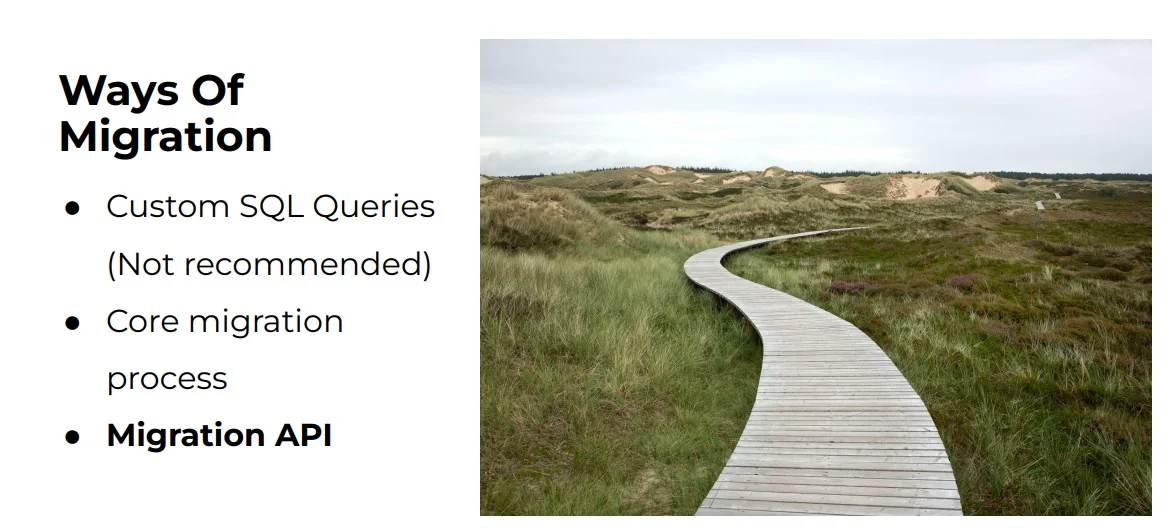
When it comes to migrating your Drupal 7 site, there are various approaches. I’ve discussed a few during my Ahmedabad meetup session:
Custom SQL Queries (Not Recommended)
While direct SQL queries are possible, they are not advised due to their complexity and potential for data corruption. Its difficult to maintain the relationship in data if we choose this option.
Core Migration Process
Drupal’s core provides migration capabilities to facilitate the process, ensuring a more structured and secure transition. Just need to set the database connection in backend and go ahead.
4) Migration API: Your Ideal Companion
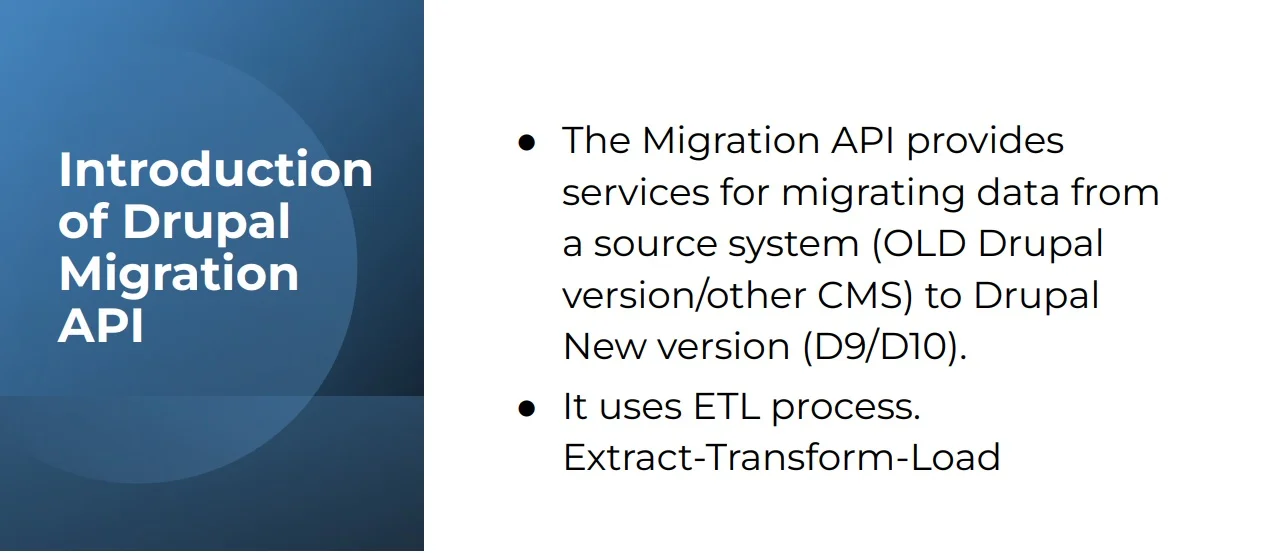
The Migration API, the star of our discussion, offers a robust mechanism for seamlessly transferring data from a source system (such as Drupal 7) to a new Drupal version (like Drupal 9 or Drupal 10). It operates on the ETL (Extract-Transform-Load) process, ensuring reliable data migration.
5) Unveiling Key Concepts in Drupal Migration
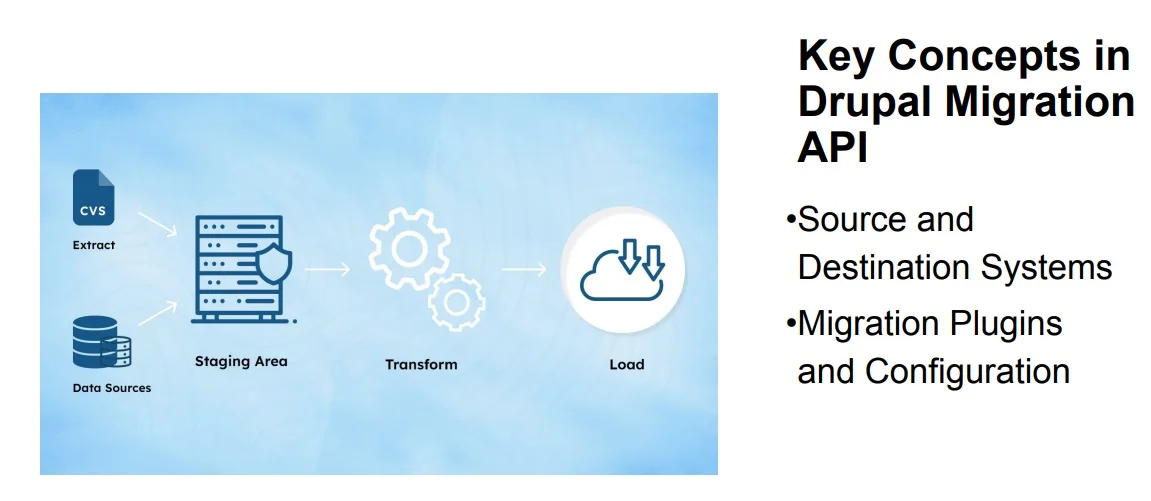
Understanding the essential elements of migration sets the foundation for a successful process:
- Source and Destination Systems: Clearly define where the data originates and where it should be placed in the new system.
Migration Plugins and Configuration: Migration handlers provide additional logic and configuration for the migration process. They allow you to define how to handle specific scenarios and customize the migration behavior.
6) Harnessing the Power of Migration Plugins :
Migration plugins are categorized into three types:
 Source
Source
 Process
Process
 Destination
Destination
Source Plugins: These plugins define the source of the data you want to migrate. Drupal supports various source plugins, including sourceUrl, sourceDatabase, sourceCsv, and more. These plugins determine where the data is coming from and how to connect to it.
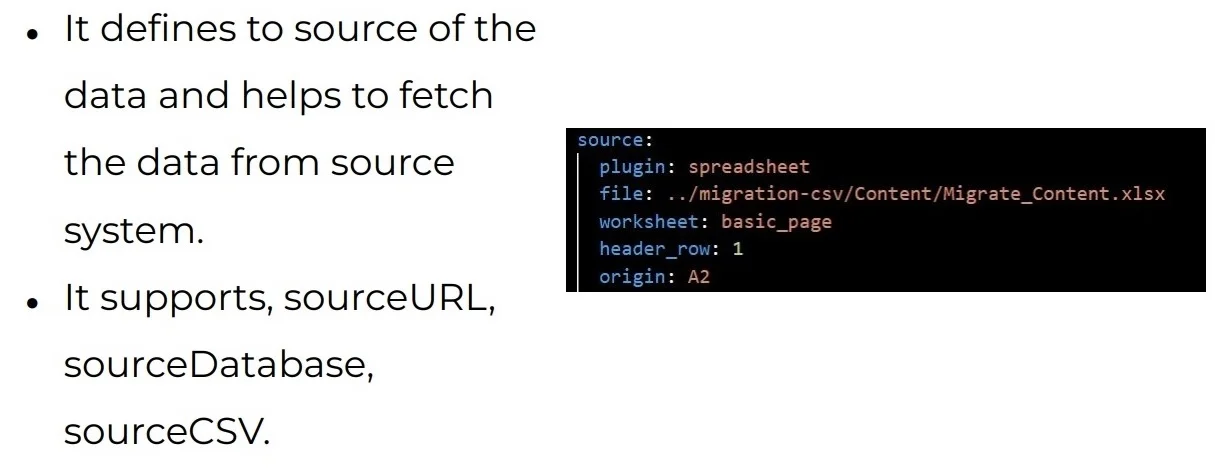
- Process Plugins:
Process plugins handle the transformation of data as it’s being migrated. They allow you to manipulate and transform data from the source format to the desired format in Drupal, these plugins facilitate tasks like skipping empty data, exploding fields, invoking callbacks, and more.
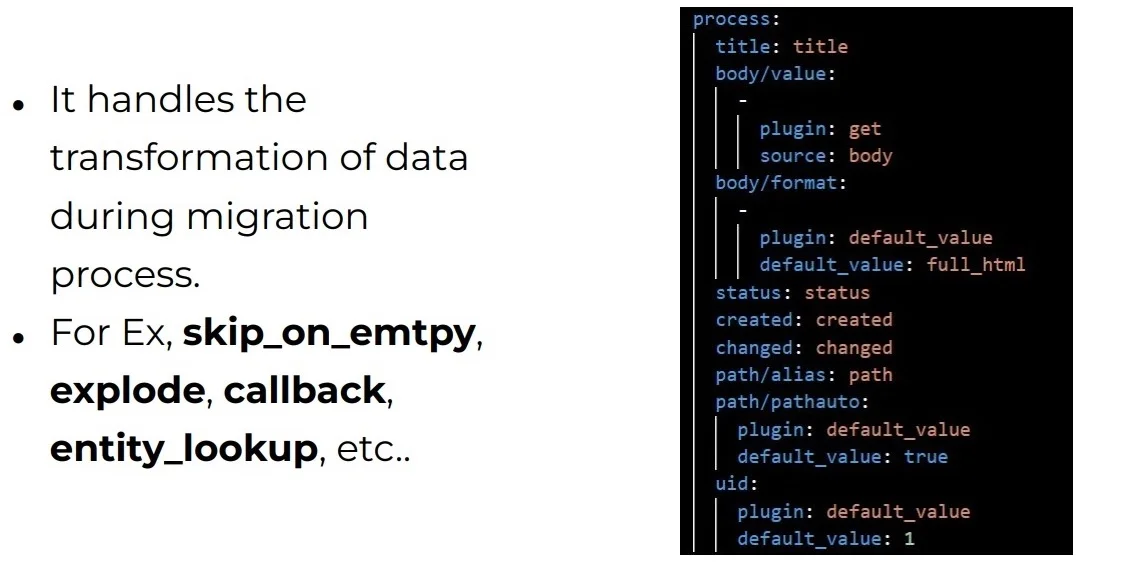
- Destination Plugins:
Destination plugins determine where the migrated data should be stored within Drupal. Common destination plugins include destinationEntity, destinationConfig, and destinationFile, a new Drupal Instance.

Process Diagram :

7) Navigating Migration: Handlers and Modules
A seamless migration journey involves mastering various aspects:
- Migration Groups:
You can organize related migrations into groups using migration groups. This makes it easier to manage and execute multiple migrations as a group.
- Migration Dependencies:
Handlers allow you to define migration dependencies, ensuring that certain migrations run before others to handle interdependent data.
- ID Mapping:
The API handles ID mapping, ensuring that data references and relationships are preserved during the migration. This is crucial to maintain data integrity and prevent broken links or references in the migrated content.
- Migration Runners:
Drupal provides several ways to initiate migrations. You can use the administrative interface, command-line tools, or custom code to execute migrations.
The Essential Modules You Need
To embark on this migration journey, certain modules are essential:
- Core Modules: Begin with “Migrate” (core) and optionally enhance your experience with “Migrate Drupal UI.”
- Contrib Modules: “Migrate Plus,” “Migrate Source CSV,” and “Migrate Spreadsheet” empower your migration process. “View Data Export” can also be handy.
Additional Tools: Drush
Practical Steps: From Source to YAML
The real magic happens during implementation. Here’s a condensed guide:
1. Export Data from Drupal 7: By using `View Data Export` contrib module, export the data in CSV or EXCEL format. Save the data with ensuring a proper naming convention and a designated folder.
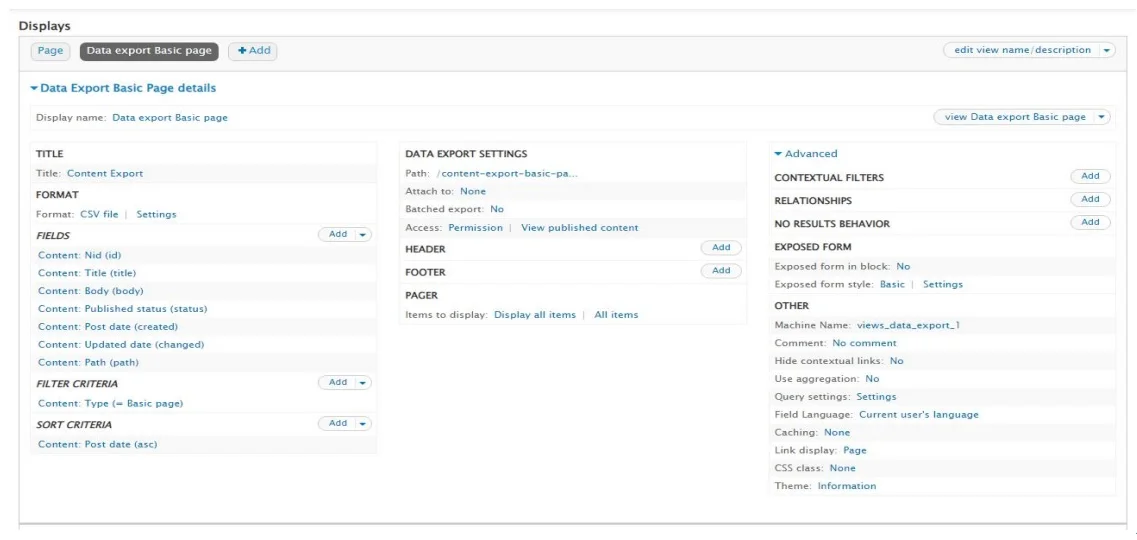
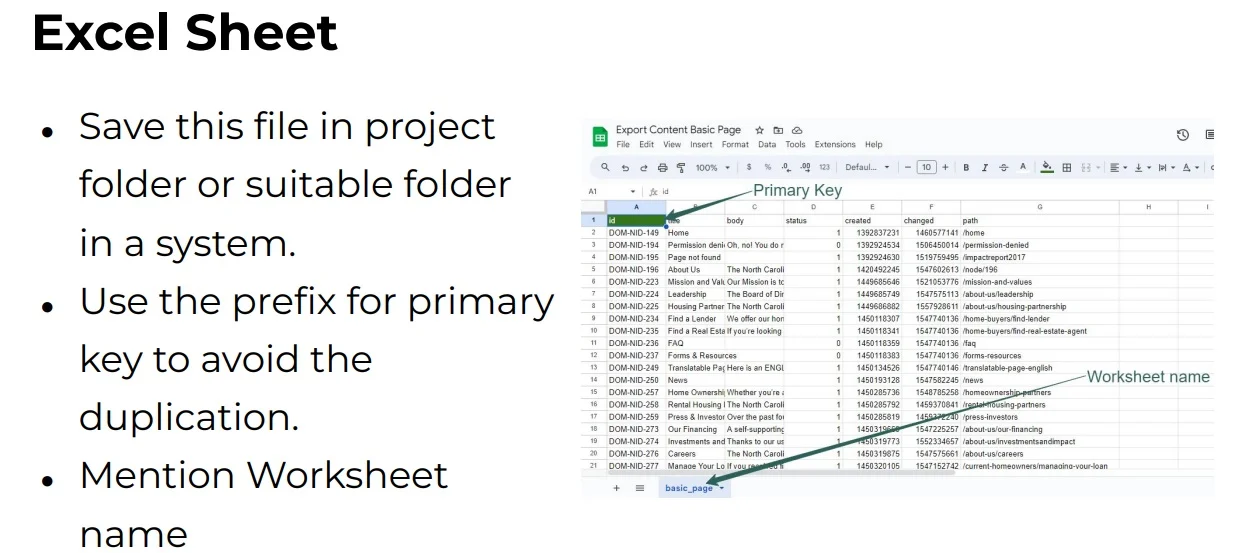
2. Prepare the YAML File: Create a YAML file outlining your migration configuration.
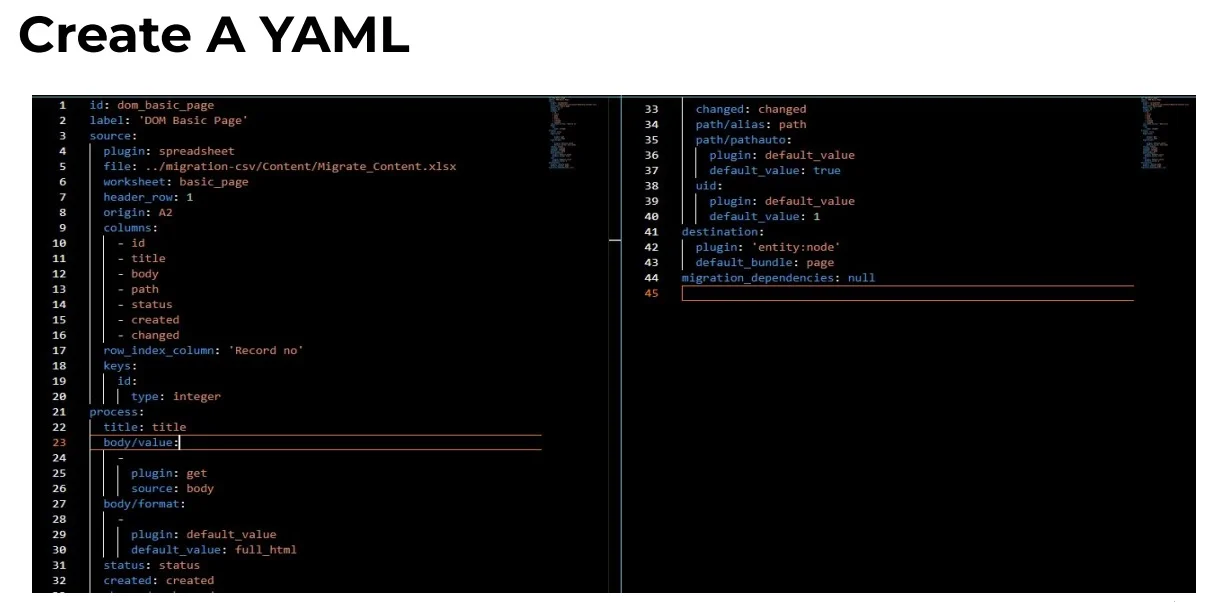
3. Import the YAML File: Store this file in the appropriate configuration folder and import it using drush cim.
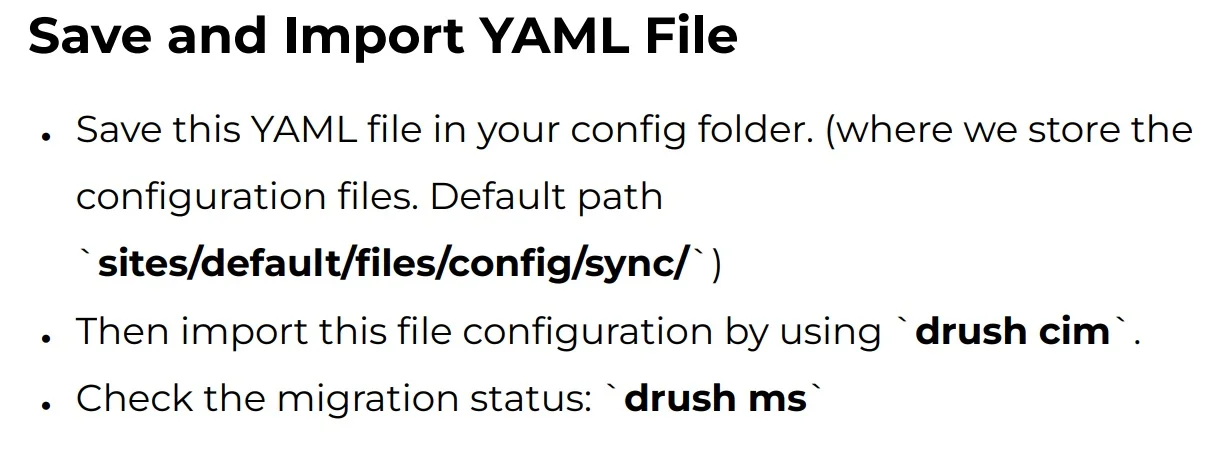
4. Check Migration Status: Use drush ms to check the source connection and records count.
Migration Status (drush ms)
 Migration Import (drush mim)
Migration Import (drush mim)
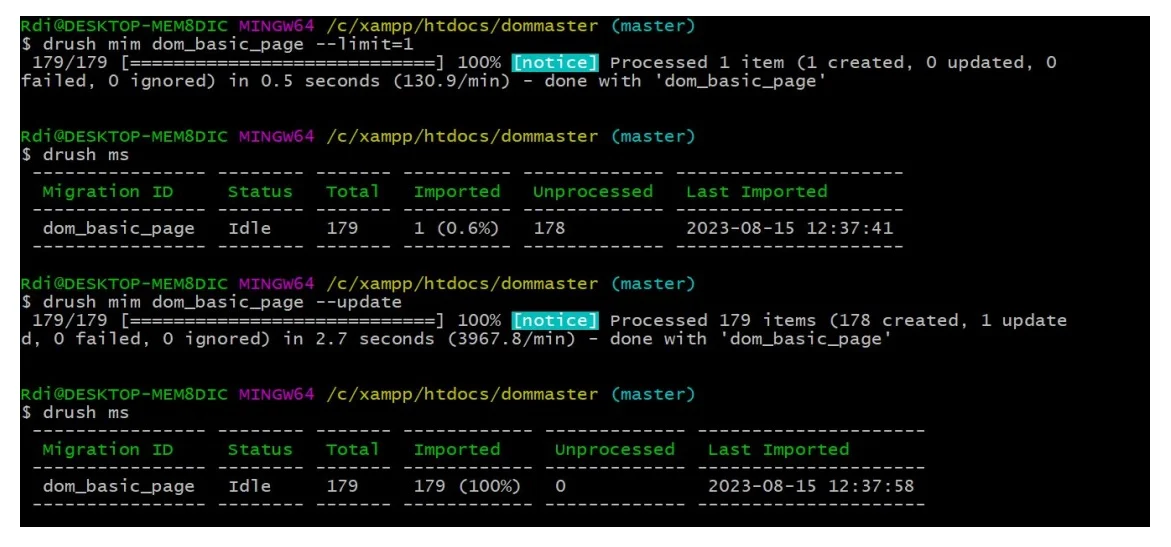
Migration Rollback (drush mr)
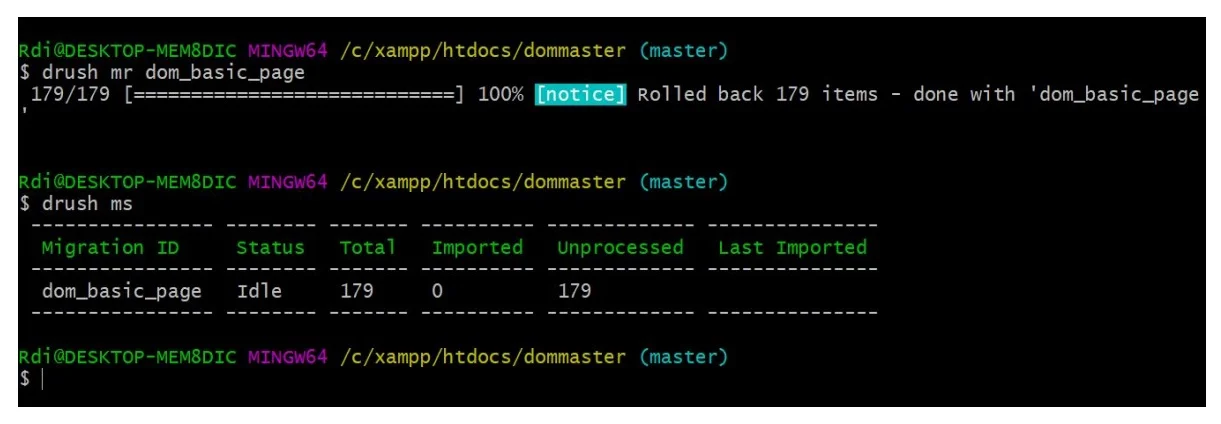
8) Running and debugging migrations requires finesse:
- Commands to Remember:
- drush ms: Check migration status.
- drush mim migration_id: Initiate migration for a specific ID.
- drush mr migration_id: Rollback a migration.
- drush mrs migration_id: Check migration state.
- drush mmsg: Access migration messages.
- Debugging
- Custom plugins
- Error Logs
- Drush mmsg
- migration _map table in database
9) Best Practices and Benefits Galore
As we near the conclusion of our migration journey, let’s highlight some best practices and the benefits you’ll reap:
- Source File Mapping: Accurate mapping ensures seamless data transfer.
- Incremental Approach: Begin with single-field migrations before moving on.
- Use of Custom Plugins: Custom plugins can aid in debugging.
- Leveraging migrate_map: Keep an eye on failed migrations.
- Streamlining Code: Eliminate redundant code for efficiency.
10) The Power of Migration API: Embrace the Advantages
Embracing the Migration API presents numerous advantages:
- Flexibility: Tailor the migration to your needs.
- Extensibility: Build upon the API to accommodate complex requirements.
- Updating Existing Entities: Seamless transition for your content.
- Precision Targeting: Migrate specific entity types with ease.
- Controlled Process: Dictate how the migration unfolds.
- Easy Rollback: Effortlessly revert to previous stages if needed.
Concluding Thoughts:

Navigating Drupal 7 migration via Spreadsheet / CSV might seem like a complex endeavor, but armed with the right tools, knowledge, and an organized approach, you can smoothly transition to newer Drupal versions. Remember, migration isn’t just about moving data; it’s about embracing the future and empowering your digital presence.
Thank you for joining me on this exploration of Drupal 7 Migration API via Spreadsheet / CSV. For a deeper dive, feel free to check out my presentation from the Ahmedabad Drupal meetup here. Happy migrating, fellow developers!
Presenter: Jayesh Makwana, Sr. Drupal Developer @cmsMinds
Drupal Meetup Ahmedabad is hosted by Krishaweb and cmsMinds.

